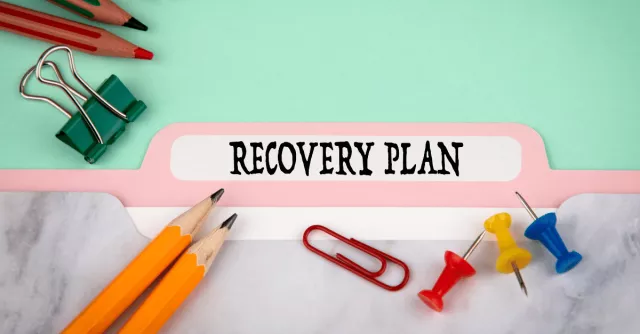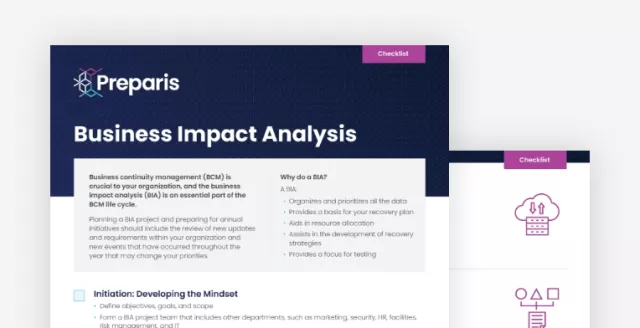End-to-End Business Continuity Management and Resilience Software Suite
RecoveryPlanner’s fully integrated cloud-based software offers mature, flexible functionality to support a comprehensive BCM program and build operational resilience.
RecoveryPlanner is an award-winning, recognized industry leader for end-to-end business continuity management (BCM) and resilience software with deep, mature functionality. Meet pertinent BCM regulations, standards, and best practices while implementing a collaborative, enterprise-wide BCM program with this scalable software.
Used by organizations in all industries and sizes and tailored for BCM, RecoveryPlanner is ideal for organizations looking for a tool to support a comprehensive BCM program that also helps to build resilience in systems and operations. RecoveryPlanner has broad, customizable, and flexible functionality for experienced practitioners yet is simple enough for casual users.
Request Your Free Demo Today
See how RecoveryPlanner can streamline your business continuity management program, giving you time to focus on the critical tasks ahead.
Request a Live Demo
See how RecoveryPlanner can build operational resilience at your organization.

Frequently Asked Questions
What are a business continuity plan (BCP), business impact analysis (BIA), and risk assessment (RA)?
A BCP outlines how a business will function if its operations get interrupted. The goal of a robust business continuity plan is to keep the fundamental processes of a company operational during a disaster and to reduce downtime. A business continuity plan may consider various scenarios, such as natural disasters, wildfires, cyberattacks, workplace violence, or any isolated incident.
The BIA is a process that determines and evaluates the potential effects of an interruption on the critical business functions and defines a recovery strategy. The results of the BIA provide the foundation for effective continuity planning with a focus on business priorities.
A risk assessment is the process of identifying the risk factors that can potentially harm an organization, analyzing the events that can damage the organization, and identifying the key functions needed for the organization to continue doing business if the event occurs. It also involves evaluating the costs associated with mitigating the risk. Evaluating the probability of an event occurring is one of the critical factors involved in risk analysis.
What processes are part of business continuity planning and BIA?
The BIA determines the priority of business functions, defines continuity timing, highlights critical dates, and assigns strategy. In order to complete a BCP, you need to start with a BIA.
Business continuity planning is the process of creating systems of prevention and recovery to deal with potential threats to an organization. The goal of business continuity planning is to enable ongoing operations before, during, and after an incident; this is the framework for establishing organizational resilience and preparedness.
The three fundamental steps to creating a business continuity program are:
- Understand your organization’s priorities – identify and prioritize business processes to define the plan(s) you need (BIA); perform a risk assessment to identify and quantify threats.
- Define your continuity strategy and build a plan (BCP)
- Maintain the program – update risk assessments, BIAs, and plans; ensure awareness and validate plans with periodic exercises
Who should be involved in developing a BIA?
Several individuals who represent different essential departments should be involved in BIA development:
-
Project lead/champion—usually a dedicated business continuity professional or a person who is assigned to build the plan for your organization
-
A member of an executive team to get leadership buy-in
-
Department heads
-
Team members who are assigned a specific task as part of the BCP
Gathering information from all necessary stakeholders is easy with RecoveryPlanner.
I already have a BC plan in place. What benefit would I get from RecoveryPlanner?
Having a business continuity plan isn’t enough; to ensure you are including the right things in your plans, best practice dictates that you work with senior management to determine business priorities by using tools like the RA and BIA.
RecoveryPlanner provides an end-to-end solution to manage your business continuity life cycle. Beyond creating, maintaining, and managing your plan, within RecoveryPlanner, you can:
-
Build your BIA
-
Make data collection and reporting easier
-
Prioritize business processes
-
Produce, track, and report on risk assessments for availability, IT, and 3rd parties
-
Automate communications, analysis, reporting, and overall plan management
-
Perform vendor management
-
Easily manage crises and incidents, as well as exercising and testing
-
Ensure your BCM program aligns with industry, regulatory, and organizational standards and maintain compliance
What types of plans can I create with RecoveryPlanner?
There is no limit to the number of plans, scenarios, teams, or tasks that you can create and maintain in RecoveryPlanner. RecoveryPlanner can be used for business continuity, crisis response, incident management, crisis communication, disaster recovery, department, COOP, emergency response, and cyber incident response plans, to name a few. Use RecoveryPlanner’s templates to create plan standardization or guide you in creating your plans. Plans can be developed for any scope and multiple scenarios.
Will RecoveryPlanner address all my reporting needs?
RecoveryPlanner’s ability to collect data throughout each phase of the BCM life cycle, produce reliable data, and perform analysis across the platform is essential to program success and addressing stakeholder inquiries. Dashboards make program management and status easier to track and implement.
RecoveryPlanner provides access to reports that help you create, update, track, and monitor the program, such as highlighting progress across plan, BIA, and RA development; GAP reports that show items that need to be addressed; and dependency reports that quickly show possible vulnerabilities and impacts from disruption.
Dashboards, high-level charts, and graphs provide executives with a snapshot of the program based on KPIs to ensure the program is effective.
RecoveryPlanner provides hundreds of pre-formatted reports you will be able to run even if you are unsure of the reports you may need. Create custom reports with simple pull-down menus and save them for continued use. Export reports to interactive Excel files, print them out, and designate them as shared or private.
Does RecoveryPlanner work on mobile devices?
Yes. As a cloud-based product, RecoveryPlanner can be accessed from any computer, tablet, or mobile device. If there is no internet, you can still use RecoveryPlanner’s mobile app, which serves as an extension of the relational database. The application focuses on incident/exercising, allowing users to view and access plans offline, files, and attachments, manage and participate in crisis communications, and update tasks during an incident or exercise. Download the RP Mobile App on iOS and Android.
Is RecoveryPlanner or Preparis Planner right for my business?
RecoveryPlanner provides additional features such as risk-based prioritization and strategy, enterprise-wide planning, real-time interactive incident management, crisis communications, audit, compliance, and reporting. It is designed to meet BCM standards and regulations.
Preparis Planner is an intuitive tool for organizations looking for a centralized business continuity platform. It provides more guidance and automation, simplifying the BC planning process, and features like DRaaS and cloud solutions, guided tabletop exercises, and tools to maintain BC plans and incident history.
We can help you decide which product best suits your business.









